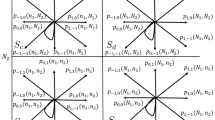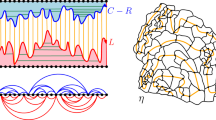Abstract
We study the stationary distribution of a random walk in the quarter plane arising in the study of three-hop wireless networks with stealing. Our motivation is to find exact tail asymptotics (beyond logarithmic estimates) for the marginal distributions, which requires an exact solution for the bivariate generating function describing the stationary distribution. This exact solution is determined via the theory of boundary value problems. Although this is a classical approach, the present random walk exhibits some salient features. In fact, to determine the exact tail asymptotics, the random walk presents several unprecedented challenges related to conformal mappings and analytic continuation. We address these challenges by formulating a boundary value problem different from the one usually seen in the literature.

Similar content being viewed by others
References
Aziz, A., Starobinski, D., Thiran, P.: Understanding and tackling the root causes of instability in wireless mesh networks. To appear in IEEE/ACM Trans. Netw. (2010)
Blanc, J.P.C.: The relaxation time of two queues systems in series. Commun. Statist. Stoch. Models 1, 1–16 (1985)
Cohen, J.W.: Boundary value problems in queueing theory. Queueing Syst. 3, 97–128 (1988)
Cohen, J.W., Boxma, O.J.: Boundary Value Problems in Queueing System Analysis. North-Holland, Amsterdam (1983)
Dautray, R., Lions, J.L.: Analyse Mathématique et Calcul Numérique pour les Sciences et les Techniques. Masson, Paris (1995)
Dieudonne, J.: Calcul Infinitésimal. Hermann, Paris (1980)
De Bruijn, N.G.: Asymptotic Methods in Analysis. Dover Publications, New York (1981)
Fayolle, G., Iasnogorodski, R.: Two coupled processors: the reduction to a Riemann–Hilbert problem. Z. Wahrscheinlichkeitstheorie Verwandte Gebiete 47, 325–351 (1979)
Fayolle, G., Malyshev, V.A., Menshikov, M.V.: Topics in the Constructive Theory of Countable Markov Chains. Cambridge University Press, Cambridge (1995)
Fayolle, G., Iasnogorodski, R., Malyshev, V.: Random Walks in the Quarter Plane. Springer, New York (1999)
Flajolet, P., Sedgewick, R.: Analytic Combinatorics. Cambridge University Press, Cambridge (2009)
Forster, O.: Lectures on Riemann Surfaces. Springer, New York (1981)
Guillemin, F., Pinchon, D.: Analysis of generalized processor-sharing systems with two classes of customers and exponential services. J. Appl. Probab. 41, 832–858 (2004)
Guillemin, F., Simonian, A.: Asymptotic analysis of random walks in the quarter plane. Submitted for publication (2011)
Guillemin, F., van Leeuwaarden, J.S.H.: Rare event asymptotic for a random walk in the quarter plane. Queueing Syst. 67, 1–32 (2011)
Guillemin, F., Knessl, C., van Leeuwaarden, J.S.H.: Wireless multi-hop networks with stealing: large buffer asymptotics via the Ray method. SIAM J. Appl. Math. 71, 1220–1240 (2011)
Kobayashi, M., Miyazawa, M.: Tail asymptotics of the stationary distribution of a two dimensional reflecting random walk with unbounded upward jumps. Submitted for publication (2011)
Kobayashi, M., Miyazawa, M.: Revisit to the tail asymptotics of the double QBD process: refinement and complete solutions for the coordinate and diagonal directions. To appear in Matrix-Analytic Methods in Stochastic Models. Springer (2012)
Kurkova, I., Raschel, K.: Random walks in \(Z_+^2\) with non-zero drift absorbed at the axes. Bull. Soc. Math. France 139, 341–387 (2011)
Li, H., Zhao, Y.Q.: Tail asymptotics for a generalized two-demand queue model—a kernel method. Queueing Syst. 69, 77–100 (2011)
Li, H., Zhao, Y.Q.: A kernel method for exact asymptotics—random walks in the quarter plane. Submitted for publication (2011)
Miyazawa, M.: Tail decay rates in double QBD processes and related reflected random walks. Math. Oper. Res. 34, 547–575 (2009)
Miyazawa, M.: Light tail asymptotics in multidimensional reflecting processes for queueing networks. TOP. (2011). doi:10.1007/s11750-011-0179-7
Muschelischwili, N.I.: Singuläre Integralgleichungen. Akademie Verlag, Berlin (1965)
Neuts, M.F.: Matrix-Geometric Solutions in Stochastic Models, An Algorithmic Approach. The Johns Hopkins Press, Baltimore (1981)
Acknowledgments
The work of CK was partly supported by NSA Grants H 98230-08-1-0102 and H 98230-11-1-0184. JvL is supported by an ERC Starting Grant.
Author information
Authors and Affiliations
Corresponding author
Additional information
An erratum to this article is available at http://dx.doi.org/10.1007/s11134-014-9418-6.
Appendix A: Resultants
Appendix A: Resultants
Generally speaking, when we have two polynomials in two variables, say,
the resultant of the polynomials \(f_1\) and \(f_2\) with respect to \(x\) is the determinant \(\mathrm Res _x(f_1,f_2)\) of the matrix
which is a polynomial in \(y\). The polynomials \(f_1\) and \(f_2\) have a non-trivial root \((x_0,y_0)\) in common if and only if the resultant with respect to \(x\) is 0 at \(y_0\). This leads to the resolution of a polynomial equation. Note that by adding to the \((m+n)\)th column, the \(i\)th column multiplied by \(x^{m+n-i}\) for \(0\le i<n+m\), \(\mathrm Res _x(f_1,f_2)\) is equal to the determinant of the matrix
which can written as \(p(x,y)f_1(x,y) +q(x,y)f_2(x,y)\), where \(p\) and \(q\) are polynomials in variables \(x\) and \(y\).
1.1 A.1. Resultants of the polynomials \(h_1\) and \(h_2\)
1.1.1 A.1.1. Resultant in \(x\)
The resultant in \(x\) is the determinant of the matrix
Straightforward computations show that
where
It is easily checked that the quadratic polynomial \(\mathcal Q _x(h_1,h_2;y)\) has two roots with opposite sign, as stated in Sect. 3. The positive root is \(y^*\) and the negative root is \(y_*\) given by Eqs. (13) and (14), respectively. In addition, the value of the polynomial \(\mathcal Q _x(h_1,h_2;y)\) at the point 1 is equal to \(p^2\), which implies that \(y^*<1\).
1.1.2 A.1.2. Resultant in \(y\)
The resultant in \(y\) is the determinant of the matrix
and is equal to
The quadratic polynomial in the right-hand side of the above equation has two real roots with opposite signs; the positive root is \(x^*\) and the negative root if \(x_*\) given by Eqs. (17) and (18), respectively.
As the value of this quadratic polynomial at the point 1 is equal to \(-p\), \(x^*>1\).
1.2 A.2. Resultants of the polynomials \(h_1\) and \(h_3\)
1.2.1 A.2.1. Resultant in \(y\)
The resultant in \(y\) of the polynomials \(h_1(x,y)\) and \(h_3(x,y)\) is equal to the determinant of the matrix
Straightforward computations show that
The roots of this polynomial are 0, 1 and \((1+p)/(1-p)\).
1.2.2 A.2.2. Resultant in \(x\)
The resultant in \(x\) is the determinant of the matrix
and is equal to
The roots of this polynomial are 0, 1, and \((1+p)/(1-p)\).
Rights and permissions
About this article
Cite this article
Guillemin, F., Knessl, C. & van Leeuwaarden, J.S.H. Wireless three-hop networks with stealing II: exact solutions through boundary value problems. Queueing Syst 74, 235–272 (2013). https://doi.org/10.1007/s11134-012-9332-8
Received:
Revised:
Published:
Issue Date:
DOI: https://doi.org/10.1007/s11134-012-9332-8




